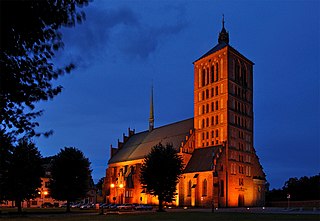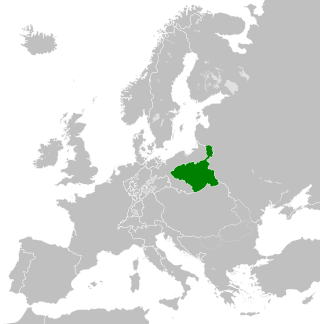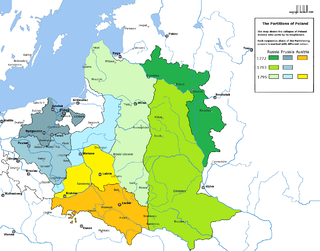Related Research Articles

The Partitions of Poland were three partitions of the Polish–Lithuanian Commonwealth that took place toward the end of the 18th century and ended the existence of the state, resulting in the elimination of sovereign Poland and Lithuania for 123 years. The partitions were conducted by the Habsburg monarchy, the Kingdom of Prussia, and the Russian Empire, which divided up the Commonwealth lands among themselves progressively in the process of territorial seizures and annexations.

Braniewo, is a town in northern Poland, in Warmia, in the Warmian-Masurian Voivodeship, with a population of 16,907 as of June 2021. It is the capital of Braniewo County.

The Kingdom of Prussia was a German kingdom that constituted the state of Prussia between 1701 and 1918. It was the driving force behind the unification of Germany in 1866 and was the leading state of the German Empire until its dissolution in 1918. Although it took its name from the region called Prussia, it was based in the Margraviate of Brandenburg. Its capital was Berlin. Due to the fact that Brandenburg was the seat of power and prominent part of the entity, the state is also referred to as Prussia-Brandenburg or Brandenburg-Prussia and sometimes erroneously as the Kingdom of Brandenburg or the Kingdom of Nordmark.

The Duchy of Warsaw, also known as the Grand Duchy of Warsaw and Napoleonic Poland, was a French client state established by Napoleon Bonaparte in 1807, during the Napoleonic Wars. It initially comprised the ethnically Polish lands ceded to France by Prussia under the terms of the Treaties of Tilsit, and was augmented in 1809 with territory ceded by Austria in the Treaty of Schönbrunn. It was the first attempt to re-establish Poland as a sovereign state after the 18th-century partitions and covered the central and southeastern parts of present-day Poland.


Congress Poland, Congress Kingdom of Poland, or Russian Poland, formally known as the Kingdom of Poland, was a polity created in 1815 by the Congress of Vienna as a semi-autonomous Polish state, a successor to Napoleon's Duchy of Warsaw. It was established when the French ceded a part of Polish territory to the Russian Empire following France's defeat in the Napoleonic Wars. In 1915, during World War I, it was replaced by the German-controlled nominal Regency Kingdom until Poland regained independence in 1918.

Galicia is a historical and geographic region spanning what is now southeastern Poland and western Ukraine, long part of the Polish–Lithuanian Commonwealth. It covers much of the other historic regions of Red Ruthenia and Lesser Poland.

The Free, Independent, and Strictly Neutral City of Cracow with its Territory, more commonly known as the Free City of Cracow, and the Republic of Cracow, was a city republic created by the Congress of Vienna in 1815, which included the Polish city of Cracow and its surrounding areas.


The Province of West Prussia was a province of Prussia from 1773 to 1829 and 1878 to 1920. West Prussia was established as a province of the Kingdom of Prussia in 1773, formed from Royal Prussia of the Polish–Lithuanian Commonwealth annexed in the First Partition of Poland. West Prussia was dissolved in 1829 and merged with East Prussia to form the Province of Prussia, but was re-established in 1878 when the merger was reversed and became part of the German Empire. From 1918, West Prussia was a province of the Free State of Prussia within Weimar Germany, losing most of its territory to the Second Polish Republic and the Free City of Danzig in the Treaty of Versailles. West Prussia was dissolved in 1920, and its remaining western territory was merged with Posen to form Posen-West Prussia, and its eastern territory merged with East Prussia as the Region of West Prussia district.

The Third Partition of Poland (1795) was the last in a series of the Partitions of Poland–Lithuania and the land of the Polish–Lithuanian Commonwealth among Prussia, the Habsburg monarchy, and the Russian Empire which effectively ended Polish–Lithuanian national sovereignty until 1918. The partition was the result of the Kościuszko Uprising and was followed by a number of Polish uprisings during the period.

Brzesko is a town in southern Poland, in Lesser Poland Voivodeship. It lies approximately 25 kilometres (16 mi) west of Tarnów and 50 kilometres (31 mi) east of the regional capital Kraków. Since Polish administrative reorganization, Brzesko has been the administrative capital of Brzesko County in Lesser Poland Voivodeship. Before reorganization it was part of Tarnów Voivodeship (1975–1998).

Bielsk County is a unit of territorial administration and local government (powiat) in Podlaskie Voivodeship, north-eastern Poland. It came into being on 1 January 1999, as a result of the Polish local government reforms passed in 1998. Its administrative seat and largest town is Bielsk Podlaski, which lies 39 kilometres (24 mi) south of the regional capital Białystok. The only other town in the county is Brańsk, lying 25 km (16 mi) west of Bielsk Podlaski.

The Partition Sejm was a Sejm lasting from 1773 to 1775 in the Polish–Lithuanian Commonwealth, convened by its three neighbours in order to legalize their First Partition of Poland. During its first days in session, that Sejm was the site of Tadeusz Rejtan's famous gesture of protest against Partition. The Sejm also passed other legislation, notably establishing the Permanent Council and the Commission of National Education. Cardinal Laws were confirmed.

Following three consecutive partitions of Poland carried out between 1772 and 1795, the sovereign state known as the Polish–Lithuanian Commonwealth disappeared from the map of Europe. In 1918 following the end of World War I, the territories of the former state re-emerged as the states of Poland and Lithuania among others. In the intervening period, the territory of the former Polish–Lithuanian Commonwealth was split between the Austrian Empire, the Kingdom of Prussia and the Russian Empire. These powers subdivided the territories that they gained and created new toponyms for the territories conquered. The subdivisions created were complicated by changes within those empires as well as by the periodic establishment of other forms of the quasi-Polish provinces led by a foreign head of state.

The Austrian Partition comprises the former territories of the Polish–Lithuanian Commonwealth acquired by the Habsburg monarchy during the Partitions of Poland in the late 18th century. The three partitions were conducted jointly by the Russian Empire, the Kingdom of Prussia and Habsburg Austria, resulting in the complete elimination of the Polish Crown. Austria acquired Polish lands during the First Partition of 1772, and Third Partition of Poland in 1795. In the end, the Austrian sector encompassed the second-largest share of the Commonwealth's population after Russia; over 2.65 million people living on 128,900 km2 of land constituting the formerly south-central part of the Republic.

The First Partition of Poland took place in 1772 as the first of three partitions that eventually ended the existence of the Polish–Lithuanian Commonwealth by 1795. The growth of power in the Russian Empire threatened the Kingdom of Prussia and the Habsburg monarchy and was the primary motive behind the First Partition.

Three Emperors' Corner is a former tripoint at the confluence of the Black and White Przemsza rivers, near the towns of Mysłowice, Sosnowiec and Jaworzno in the present-day Silesian Voivodeship of Poland. During the Partitions of Poland, from 1871 to 1918, it marked the place at which the borders of three empires that had divided Poland – the Russian Empire, Austria-Hungary and the German Empire – met.

Austria–Poland relations are foreign relations between Austria and Poland. The two nations have a very long historical relationship dating back several centuries, which has been complicated throughout most of their history.

Greater Poland, often known by its Polish name Wielkopolska, is a Polish historical region of west-central Poland. Its chief and largest city is Poznań followed by Kalisz, the oldest city in Poland.
References
- (in Polish) Joanna Strzelecka, Powszechne spisy ludności, Kancelaria Sejmu, Biuro Studiów i Ekspertyz, Informacja Nr 890, 4/2002